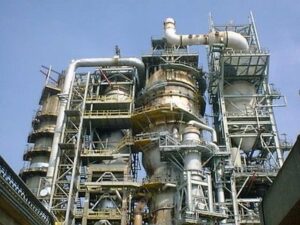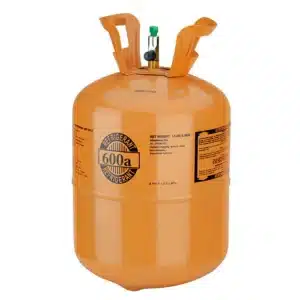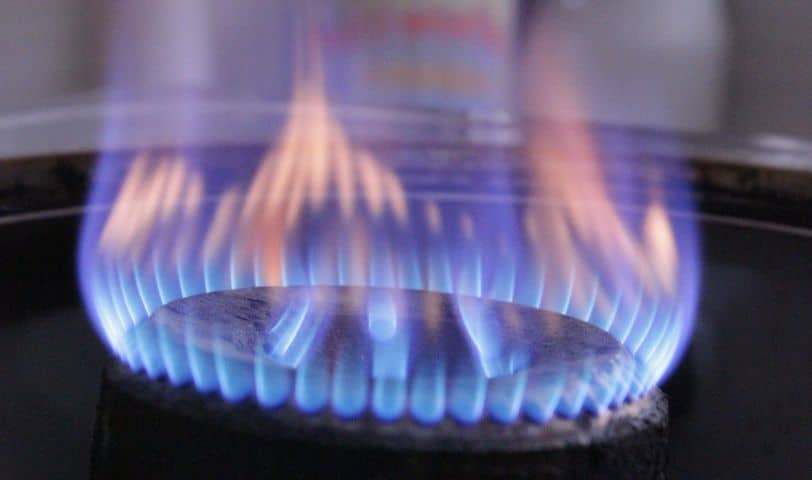Isobutane vs Butane – r600a Isobutane Refrigerant – Isobutane Gas – What is Isobutane?
Regarding isobutane vs butane, isobutane (i-butane) is an isomer of normal butane (n-butane).
That means that the chemical formula for isobutane – C4H10 – is the same but has a different arrangement of its carbon and hydrogen atoms.
Isobutane (isobutane gas) is converted from butane in a isobutane production process called isomerization.
Isobutane (isobutane gas) is also classified as an LPG – liquefied petroleum gas – as are butane and propane.
The main use of isobutane is in refineries, as a gasoline – petrol – additive and also as an isobutane refrigerant, called r600a isobutane refrigerant.
However, isobutane (isobutane gas) is different in some important ways.
What is Isobutane?
Isobutane is a flammable hydrocarbon gas.
Isobutane is an isomer of butane, meaning it has the same chemical formula as butane – C4H10 – but has a different arrangement of its carbon and hydrogen atoms.
Isobutane is commonly used as a refrigerant, called r600a isobutane refrigerant, and as a refinery additive to gasoline.
Isobutane Canister – Isobutane Cartridge for Isobutane Camping Stove & Isobutane Lantern
An isobutane canister (isobutane gas canister) or isobutane cartridge is a small container used for the sale of small quantities of isobutane gas.
Isobutane canister uses include portable isobutane stove (isobutane camping stove), isobutane lantern, and other isobutane canister devices.
Isobutane Refrigerant: r600a Isobutane Refrigerant
Isobutane (isobutane gas) is commonly used as an isobutane refrigerant, called r600a isobutane refrigerant.
r600a isobutane refrigerant is a refrigerant grade isobutane gas.
r600a isobutane refrigerant can be used as a replacement for R-12, R-22, R-134a in conventional refrigeration systems.
R-290a is a mixture of isobutane and propane.
Isobutane (isobutane gas) is an excellent refrigerant and eco-friendly minus the ozone harming properties of CFCs.
Isobutane Physical Properties:
Isobutane Chemical Formula, Isobutane Boiling Point, Isobutane Vapor Pressure, Isobutane Density, etc.
The following chart shows some of the isobutane (isobutane gas) physical properties including the chemical formula of isobutane, isobutane boiling point, isobutane vapor pressure and isobutane density.
You can refer back to the chart as we explain the importance of the numbers in the following isobutane (isobutane gas) topics.
| Isobutane Gas Properties | Isobutane |
| Chemical Formula for Isobutane | C4H10 |
| Energy Content: MJ/m3 | 110.4 |
| Energy Content: MJ/kg | 45.59 |
| Energy Content: MJ/L | 25.0 |
| Isobutane Boiling Point: Cº | -11.75 |
| Isobutane Vapor Pressure @ 21ºC: kPa | 310.9 |
| Flame Temp: Cº | 1975 |
| Expansion: m3/L | 0.234 |
| Gas Volume: m3/kg | 0.402 |
| Relative Density: H2O | 0.60 |
| Relative Density: air | 2.07 |
| L per kg | 1.669 |
| kg per L | 0.60 |
| Specific Gravity @ 25ºC | 2.06 |
| Isobutane Density @ 15ºC: kg/m3 | 2.533 |
| Isobutane Molecular Weight: g/mol | 58.12 |
Isobutane Chemical Formula (Chemical Formula of Isobutane or Chemical Formula for Isobutane)
Butane vs Isobutane: Difference Between Butane and Isobutane – Isobutane Structure
 When considering butane vs isobutane, the difference between butane and isobutane is that isobutane (i-butane) is an isomer of normal butane (n-butane).
When considering butane vs isobutane, the difference between butane and isobutane is that isobutane (i-butane) is an isomer of normal butane (n-butane).
That means the chemical formula for isobutane is the same as butane – C4H10 – but isobutane structure has a different arrangement of its atoms, as you can see in the 3-D model images. (Isobutane molecule model of isobutane structure shown)
As with normal butane (n-butane), isobutane (i-butane) is a flammable hydrocarbon gas that is liquefied through pressurisation.
However, isobutane (isobutane gas) has different physical properties from normal butane (n-butane), including isobutane boiling point vs butane boiling point (boiling point for butane) and isobutane vapor pressure.
Isobutane is colourless with a weak petrol odour.
Isobutane (isobutane gas) is very flammable and gas/air mixtures can be explosive.
Isobutane vapour (isobutane gas) is heavier than air.
Isobutane is classified as LPG, along with propane, butane and mixes of these gases.
Isobutane Vapor Pressure
Isobutane vapor pressure is different from butane and propane, at about 64% less vapour pressure than propane but about 44% more than butane (at 21ºC)
Isobutane vapor pressure is 310.9kPa at 21°C.
Is Isobutane Toxic – Isobutane Toxicity
Isobutane toxicity is mostly a case of displacing oxygen, as an asphyxiant, at high enough concentrations.
Liquid isobutane can also cause frostbite if it makes contact with bare skin.
Isobutane side effects in high concentrations can cause dizziness, lightheadedness, headache, nausea, and even unconsciousness.
In very high concentrations isobutane can displace oxygen in the air, leading to rapid suffocation.
You should consult an Isobutane SDS for full information on isobutane toxicity.
Isobutane Production Process from Butane
 Isobutane (isobutane gas) production is converted from butane (n-butane) in a process called isomerization.
Isobutane (isobutane gas) production is converted from butane (n-butane) in a process called isomerization.
This isomerization happens in something called a butamer unit and includes the use of platinum or another metal catalyst.
In this isobutane production process, only some of the butane is actually converted to isobutane.
After the butamer process, the output mixture goes through a fractionator or deisobutanizer tower that separates the unconverted butane from the isobutane production.
The isobutane (isobutane gas) production process rearranges the atoms into a different molecular configuration.
The component atoms of isobutane (isobutane gas) are the same but are arranged in a different geometric structure.
Common Isobutane Uses – What is Isobutane Used For? r600a Isobutane Refrigerant
Isobutane uses are primarily in refineries, as a gasoline – petrol – additive, and also as an isobutane refrigerant, called r600a isobutane refrigerant.
There, isobutane is processed through an alkylation unit to make an alkylate.
Isobutane is used to make isooctane, a high octane gasoline component, which increases the octane rating and anti-knock properties of gasoline.
isobutane (isobutane gas) is rated at 100 points on the octane rating scale.
As previously mention, isobutane (isobutane gas) is frequently used as an isobutane refrigerant, called r600a isobutane refrigerant.
Whilst isobutane (isobutane gas) is flammable, there have been few problems in the millions of r600a isobutane refrigerant units worldwide.
r600a isobutane refrigerant has very low global warming potential and insignificant ozone depletion potential.
Another important use of isobutane is as a feed stock for plastics.
It is used to manufacture propylene oxide for use in making polyurethane plastics.
Isobutane is also used as a solvent.
Isobutane & Butane Vapor Pressure & Use as an Aerosol Propellant
 Isobutane (isobutane gas) and butane are used as aerosol propellants.
Isobutane (isobutane gas) and butane are used as aerosol propellants.
One of the other important differences between isobutane, butane and the other LPG gases is vapour pressure.
Vapour pressure is the pressure exerted by the vapour (gas), in equilibrium with the liquid, against the walls of the cylinder or other closed container at a given temperature.
Isobutane (isobutane gas) has about 64% less vapour pressure than propane but about 44% more than butane (at 21ºC).
Propane, butane and isobutane are all used as propellants in aerosol products, as they are naturally odourless or nearly odourless, non-corrosive and non-toxic.
For obvious reasons, no stenching odourant is added to the LPG when used as a propellant.
Nobody wants stinky aerosol products!
These gases may be used individually or in combinations to achieve the desired pressure.
The lower pressures of the two butanes tend to be favoured for everything from deodorant to disposable cigarette lighters.
When the product label lists “hydrocarbon” as the propellant, it is often isobutane (isobutane gas) or butane.
LPG gases replaced chlorofluorocarbons (CFCs) as propellants about 30 years ago.
CFCs were banned because they damaged the ozone layer of the atmosphere.
Isobutane Refrigerant, Butane and Propane in Refrigerant Applications
All three LPG gases are used in refrigeration but for different applications.
 They have different refrigeration uses because of their different thermodynamic properties.
They have different refrigeration uses because of their different thermodynamic properties.
They are used to replace the harmful CFC refrigerants, such as R-12, R-22, R-134a.
Isobutane refrigerant (isobutane gas) is used as a refrigerant known as R600a.
Both Butane (R-600) and high purity propane (>97.5%), known as R290, are also used as a refrigerants.
The three gases can also be mixed to achieve different properties, such as with R-290a, a mixture of isobutane and propane.
Just as with propellants, LPG gases also replaced chlorofluorocarbons (CFCs) as refrigerants, to preserve the ozone layer.
Is Isobutane Flammable? Isobutane Combustion & Limits of Flammability
Isobutane (isobutane gas) is extremely flammable and can form an explosive gas/air mixture with air.
Isobutane (isobutane gas) limits of flammability are 1.8% to 8.4%, by volume.
Assuming complete combustion, you get carbon dioxide and water:
2 C4H10 + 13 O2 → 8 CO2 + 10 H2O + Heat
However, with incomplete combustion you get carbon monoxide and water
2 C4H10 + 9 O2 → 8 CO + 10 H2O + Heat
This would typically occur if the ratio of oxygen to isobutane was insufficient.
Butane Boiling Point (Boiling Point for Butane) & Isobutane Boiling Point: Vaporisation
Isobutane boiling point and butane boiling point (boiling point for butane) are different, which is the temperature at which they go from liquid to gas (vapour).
Isobutane boiling point is at -11.75°C, whereas butane boiling point is at -0.4°C.
This means you have a problem if you try to use pure isobutane when the temperature drops below -11.75°C or when the butane boiling point (boiling point for butane) is below -0.4°C.
No boiling, no vapourisation, equals no gas. So, when it gets cold, you could find yourself without gas for your heater and cooking appliances.
However, propane and butane are less costly, so isobutane is rarely used in large amounts as heating fuel.
In some areas, LPG suppliers provide just propane or a blend of propane and butane to address this problem.
This can work well when there are temperatures both below and above freezing.
Needless to say, propane is the preferred choice for cold weather climates, as propane boiling point is at -42°C versus butane boiling point (boiling point for butane) at -0.4°C.
Isobutane and Butane are Liquefied Petroleum Gas
Both isobutane (isobutane gas), butane, and propane are hydrocarbon gases that fall under the broad label of “LPG” because they are all liquefied petroleum gases.
They are a group of flammable hydrocarbon gases liquefied through pressurisation and commonly used as fuel.
They are also called Natural Gas Liquids (NGL), along with ethane, pentane, and pentanes plus.
Their common distinguishing characteristic is that they can be compressed into liquid at relatively low pressures.
All are used as fuel in combustion and for heat generation, but LPG has many other applications.
Final Thoughts on Isobutane and Butane
Many people have never even heard of isobutane (isobutane gas), but it affects their everyday lives.
This odourless gas keeps cars from knocking (pre-ignition), is an environment-friendly refrigerant, and is a common propellant for hairspray, deodorant and other aerosols.
Isobutane also contributes to a variety of plastic products and solvents.
Most importantly, isobutane (isobutane gas) is a great LPG fuel for cold climates where butane boiling point is such that it would not boil and produce sufficient vapour pressure.
So, whilst nearly unknown, isobutane (isobutane gas) is important nonetheless.
- BBQ – Gas and Charcoal BBQ Features – Charcoal BBQ vs Gas BBQ Comparison - March 31, 2025
- GPL Gas (GPL Fuel) – GLP Gas – LPG Gasul: GLP – GPL Station Near Me - March 26, 2025
- Think LPG When Building a New Home - February 26, 2025
Steve Reynolds
Technical Consultant
Steve Reynolds is a leading expert in the LPG industry with over 22 years of experience. As part of the national management team at ELGAS, Steve ensures the safe and efficient storage, handling, and transportation of LPG. He serves as the lead investigator for incidents and collaborates with authorities on industry developments.
Steve is a technical advisor to Standards Australia and Gas Energy Australia (GEA), and an active member of the World LPG Association (WLPGA), contributing to global standards and technical reviews. He holds a BSc. (Hons) in Industrial Chemistry from UNSW and has held senior safety and technical roles at ELGAS, making him a trusted authority in LPG safety and standards.
New Residential LPG customer?
New Business LPG customer?
Existing ELGAS customer?

